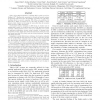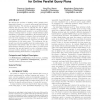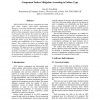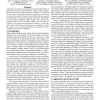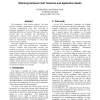143
Voted
ICDCS
2012
IEEE
13 years 2 months ago
2012
IEEE
Today’s largest High Performance Computing (HPC) systems exceed one Petaflops (1015 floating point operations per second) and exascale systems are projected within seven years...
DSN
2011
IEEE
13 years 12 months ago
2011
IEEE
— This paper describes a modeling framework for evaluating the impact of faults on the output of streaming ions. Our model is based on three abstractions: stream operators, strea...
112
Voted
SIGMOD
2011
ACM
14 years 3 months ago
2011
ACM
We address the problem of making online, parallel query plans fault-tolerant: i.e., provide intra-query fault-tolerance without blocking. We develop an approach that not only achi...
117
Voted
ICDCSW
2007
IEEE
15 years 10 days ago
2007
IEEE
—Application mobility is an efficient way to mask uneven conditioning and reduce users’ distractions in pervasive environments. However, since mobility brings more dynamism and...
111
Voted
COMPSAC
2004
IEEE
15 years 4 months ago
2004
IEEE
Off-The-Shelf (OTS) software components are being used within complex safety-critical applications. However, to use these untrustworthy components with confidence, it is necessary...
142
Voted
DATE
2009
IEEE
15 years 4 months ago
2009
IEEE
1 In this paper we propose an approach to the design optimization of fault-tolerant hard real-time embedded systems, which combines hardware and software fault tolerance techniques...
112
Voted
IFIP
1989
Springer
15 years 4 months ago
1989
Springer
The designation “fault tolerant software” has been used for techniques ranging from roll-back and retry to N-version programming, from data mirroring to functional redundancy....
102
Voted
WOSS
2004
ACM
15 years 5 months ago
2004
ACM
The development of dependable software systems is a costly undertaking. Fault tolerance techniques as well as self-repair capabilities usually result in additional system complexi...
92
Voted
ICCD
2003
IEEE
15 years 9 months ago
2003
IEEE
We analyze the effect of errors in branch predictors, a representative example of speculative processor subsystems, to motivate the necessity for fault tolerance in such subsystem...
